| My best girl Nancy, sipping clear milk from a cold green coconut on Ipanema Beach, Rio de Janeiro, Brazil. Lovers, body builders, bike riders, volley ball players, and sand castle builders all around us. |
| "Tall and tan and young and lovely The girl from Ipanema goes walking And when she passes, each one she passes goes - ah". "The Girl From Ipanema", 1962, music by Antonio Carlos Jobim, lyrics by Vinicius de Moraes. |
Anyone familiar with music from the 60's knows the song, recorded by everyone from Frank Sinatra to Andy Williams. The girl in the song was a real person, a gorgeous 15 year old brunette, 5 feet 8 inches tall, who would come by, more to go into a club to buy cigarettes for her Mom than to go to the beach. The Veloso bar where she walked is a short distance from our hotel in the Leblon section of Rio- and very near the beach just a few blocks beyond.
Come spend a week with us! In Rio de Janeiro as part of our 50th Wedding Anniversary, we went everywhere and had the time of our lives. Come with us and we'll show you why you will want to travel to Rio, too.
|
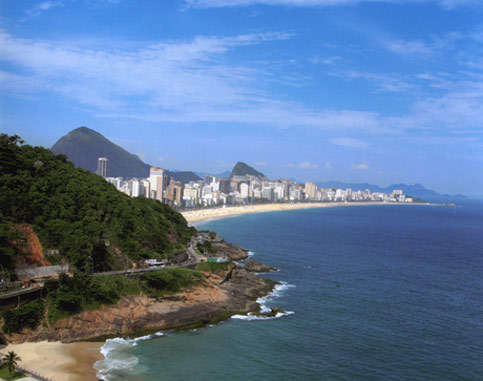
Photo: Overlooking Leblon, some of the most expensive real estate in Rio de Janeiro
Whenever you think of exciting cities to visit, one name is high on every traveler's list: Rio de Janeiro. Its natural surroundings make for broad sweeping vistas, great beaches with names everybody recognizes- Ipanema, Copacabana; Sugarloaf Mountain with its cable car; the legendary night clubs with their sambas and Bossa Novas. Don't forget world renowned Carnival and certainly include the iconic statue of Christ the Redeemer with its outstretched arms embracing the whole of the city from its mountaintop.
There are shameful, cluttered slums, home to the seriously less fortunate, hunkered right next to gleaming, ultra luxurious condominiums along unbelievably expensive beachfront property.
Really a Fun City! There is a reason why travelers dream of going to Rio de Janeiro, and it lives up to all your expectations. It is a complex, sophisticated place, made up of many different "neighborhoods", with so many things to do and see that it is understandable we would love to go again.
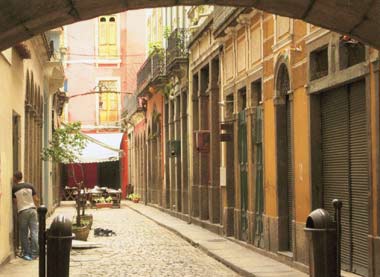
Photo: Historic district at Arco do Teles
Where to start? Let's explore the "historic" side of Rio first. In the center of the city, very near the jam-packed local market area, is the Arco do Teles, which opens up onto an area of beautifully restored, two story colonial houses, set on cobblestone streets. We marvel at the level of quality achieved in the woodwork gables and wrought iron work on the balconies.
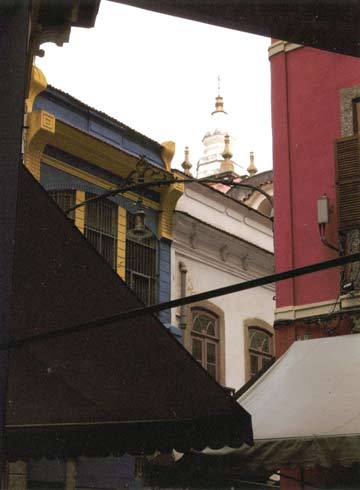
The whole area is now a mass of restaurants, cafes, bars, art galleries, and boutique shops. It is one of Rio's most popular areas, and we are told that if you have not arrived by 10PM, don't bother because you won't find a seat anywhere.
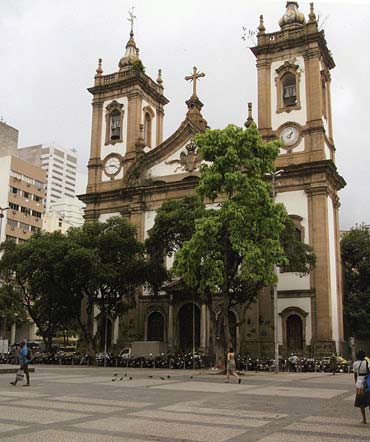
These buildings are not very old by European standards, but share an interesting history in the development of the city. Originally on the docks of the harbor, land fill in front of them reduced their previously critical location at wharf side. They fell into disrepair, but have been refurbished and now represent the elegance and grace that was originally the heart of colonial
Rio de Janeiro. |
|
So much more to see and do in Rio de Janeiro. Give yourself time.
|
For example: Carnival.
For almost a week, everything in the country stops. The huge party explodes in color, music, dances, parades in the streets. Beautiful people, gorgeous costumes. Constant energy, movement, emotion.
Day and night. And as soon as Carnival is over, they start to plan for next year's event.
We are here near Christmas, and Carnival is yet some time off. However, the excitement is building as everyone and everything is geared toward participating in Carnival.We visited a "magnet school" which is known throughout the area for training students who consistently perform well in the parade and dance competition at Carnival. Hope you can pick up the infectious excitement and enthusiasm of the kids from this photo:

Rio de Janeiro is one of the favored ports of call for cruise ships. Unfortunately, when they dock, everybody rushes off for Sugarloaf Mountain, then the Redeemer statue, then back to the ship, ignoring so much of what the city has to offer. Such as:
Beautiful architecture in the heart of downtown Rio... |
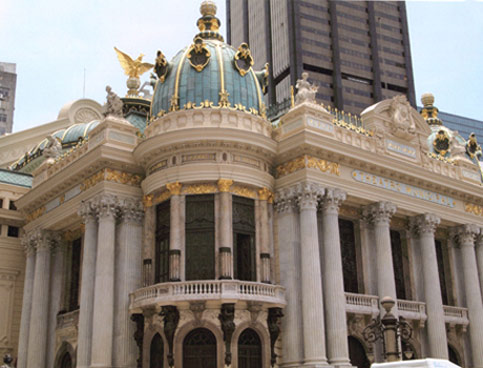
Easily the most elegant building in downtown Rio is the Teatro Municipal, one of the largest stages in Latin America. It dates from 1906, and the interior is just as splendid as the exterior, featuring stained glass windows, rose colored marble ceilings, and a huge, half-ton crystal chandelier. Unfortunately, it is not handicapped accessible, but it is delightful to just walk around and appreciate the skills that went into its construction- as well as the dedication of those who were determined to see its refurbishment lived up to the quality of the original building.
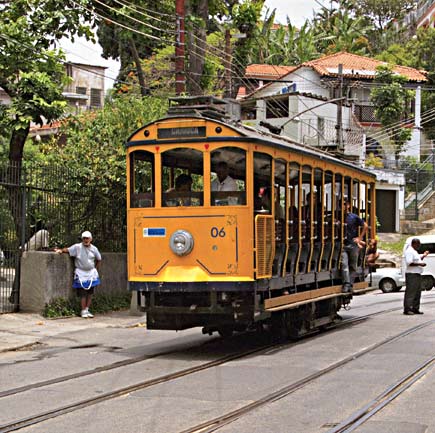
Photo: Entering District Santa Teresa by streetcar
On a hillside above the center of Rio is the District of Santa Teresa, one of Rio's oldest neighborhoods. Started next to a convent in the 18th century, it used to be the most elite area of the city, but suffered a decline- as seems to be the fate of so many similar areas. The streetcar, a great tourist attraction in itself, takes you back and forth to the heart of the downtown area, all for a cost of less than a dollar. Unfortunately, it is impossible to load a wheelchair onto this lovely conveyance.
Today, younger and more affluent residents are moving in, transforming the neighborhood back to the grandeur it once displayed.

Many of the new owners are artists. Lest you be fooled, the bicycle is real- but all three people are paintings.
**************************************************
After a fantastic morning of sightseeing, we had our guide, Marcelo, drop us off at a great seafood restaurant in Copacabana, then walked back to the hotel, a distance of close to 10 miles. With so much to see, so much to enjoy, the distance was hardly noticeable- though it was impossible to ignore the heat (close to 100 degrees) and humidity. We stopped at one of the innumerable snack places along the beach and had a cooling drink of fresh coconut juice.
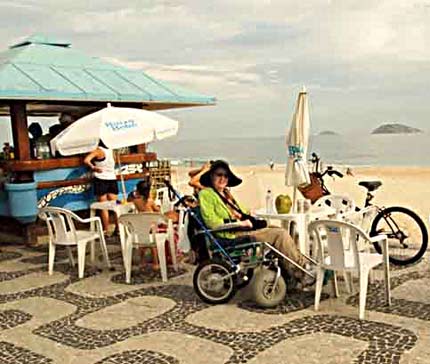
Photo: 100 degrees, 98% humidity, 1 cold coconut juice. Perfect!
Midday, midweek, the spotlessly clean beaches were crowded with bathers, foot volleyball players, and all manner of people simply enjoying life and their city. Everything about the place lends itself to your letting go, gently urging you to ease away from worry and care. You slip effortlessly into the "good life", however simple that may be.
The black and white "path" is made up of individually placed pieces of tile. The path is quite wide, and the designs and patterns vary as you walk along from what you see in this photo.
The path runs the whole length of Copacabana's 5km, and continues on to Ipanema Beach, in an ever changing atmosphere that simply captivates you and takes over your existence for whatever time you are there.
|
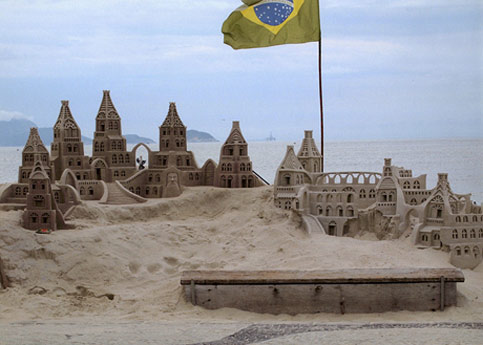
As we walked along, we came across this spectacular sand sculpture that will forever change what comes to mind when you think of building castles in the sand at the beach when you were a child!
The fellow responsible for this unusual piece of art collects pennies from tourists like us who stop to take photographs of his creation.
The second most popular spot to visit in Rio is Sugarloaf Mountain. It reminds us of Peanuts' dog Snoopy, laying on top of his doghouse. |
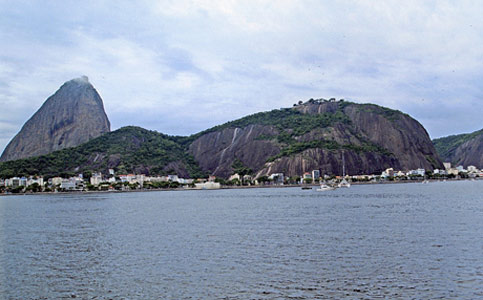
Photo: Sugarloaf Mountain viewed from across the harbor of Rio de Janeiro
A cable car runs from the tip of "Snoopy's nose" to the buildings resting on his "belly button". It is estimated that since it was built a hundred years ago (1912), more than 40 million people have visited here, largely because of the views possible from its peaks. Of course, we must go.
For all its popularity, the day we visited the elevator to get to the cable e car itself was not working, and only a steep stairway was available. Not to worry- As has been the case so many times before in out travels, within a minute or two we had assembled a team of 6 or 7 people all demanding to help us.

The entrance to the cable car is just beyond this "gear house" and accompanying tourist shop. Nancy fell in love with the two native figures, but they were a little too big to fit in our suitcases!
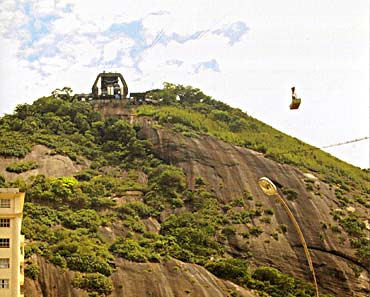
The cable car ride to the top of Sugarloaf Mountain is quite breathtaking, and for someone like me- afraid of heights- it was a challenge to keep my heart from pounding out of my chest.
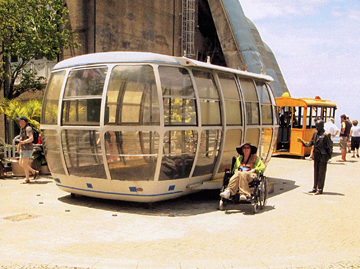
At the top of the ride are these two cable cars. The yellow one on the right is the original car, now 100 years old. The car behind Nancy is a duplicate of the Swiss-made (naturally) cable cars currently in use. |

Photo: The heart of Rio de Janeiro viewed from Sugarloaf Mountain
From the top of Sugarloaf, this is a panoramic photograph of the loveliest part of Rio de Janeiro, 1400 feet below us. In the near-left center is the beach at Ipanema. At the far-right center is the beach at Copacabana. |
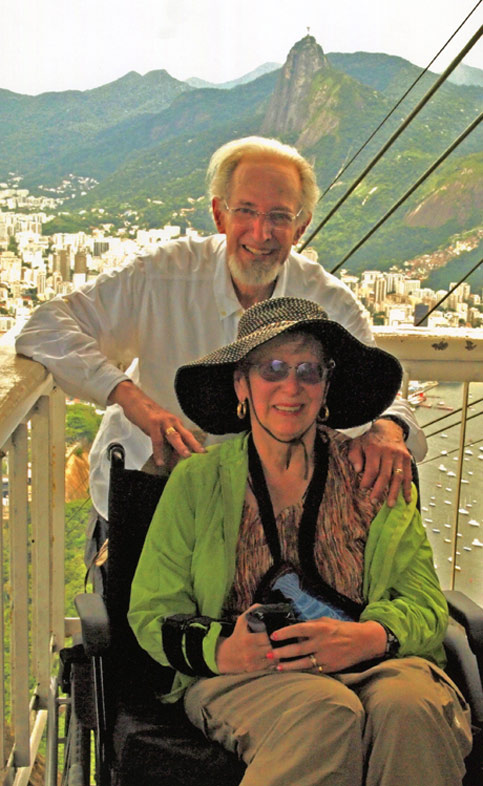
The views from here are nothing short of spectacular! Just over my head is Cocovado Hill (elevation 2,300 feet) with the statue of Christ the Redeemer atop it (more to come below). Cocovado is in the Tijuca National Park. At 8000 acres, it is the largest urban rainforest in the world.
The water beneath us in the photo sparkles with a hundred or more yachts, anchored in an exclusive yacht basin in Rio. Though they are not the size and grandeur of the Mediterranean yachts anchored in Cannes, Nice, or Monaco, they are quite respectable and you would not be ashamed to be invited aboard!
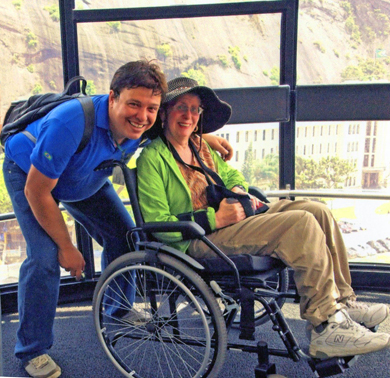
Marcelo Nogueira, our guide, snuggles next to Nancy for a picture. This ambitious young man has a university degree in business and finance, and teaches history at a local high school, filling in his family income as a guide. He made this trip ultra fantastic for us! (if you are not able to use the hyperlink, cut and paste [email protected] into your email provider).
*********************************************
We have often remarked at this web site on the value of having someone with you who knows the area you are seeing. Marcelo was a perfect example of how much more there is to know about a place than you can get from a guide book.
Armed with a listing of cruise ship dockings, he holds off taking us to Rio's Number One Tourist Attraction, the statue of Christ the Redeemer on top of Corcovado Mountain, until a day no ships will be docking in port. This assures us we will not run into the usual chaos of unmanageable tourist crowds.

He also knows to do things no tourist would know to do. Here, with a hundred people already lined up on the platform to take the train up the mountain, he directs the train into position to board Nancy ahead of the crowd. Please note Nancy has been given a "lender" wheelchair by the authorities who run the transport system. It is smaller than her own chair, creating fewer space problems.

About halfway up the mountain, a band gets on the train. They begin to play, then one of the passengers gets up to dance. In seconds, half the car is doing a samba.
Finally at the top! Having been warned this is the top attraction in virtually all of South America, we are not surprised the observation area is packed with people. It is hard to find a way to compose a picture that does justice to the grandeur of this sculpture because its massiveness just fills all the space around you.
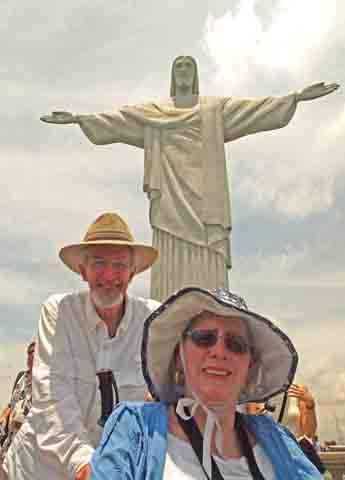
Photo: Nancy and Nate beneath the statue of Christ the Redeemer, Rio, Brazil
Whenever you see pictures of Rio de Janeiro, there will always be a photo of this statue. Conceived in 1921, it was decided to build the structure using soapstone and concrete instead of steel- which would have made everything much too heavy. The materials were hauled up the mountain by the same railroad we used today- the one where everyone is dancing the samba.
Construction was started in 1926, and the statue was dedicated in 1931. In today's dollars, the project cost a bit over $3,000,000.00.
The statue was struck by lightening during a violent electrical storm in February 2008, suffering some damage on the fingers, head, and eyebrow. In April that same year, graffiti was sprayed on the head and right arm. Go figure.
Books are written with statistics telling you how wide, how high, how many tons, etc., but so what? We can tell you it is impossible to sense the size and power of this monument from our photograph. It is simply too overpowering to capture such things in a close-up photograph. |
So much more to see and do in Rio de Janeiro. Give yourself time. |
For example: Carnival.
For almost a week, everything in the country stops. The huge party explodes in color, music, dances, parades in the streets. Beautiful people, gorgeous costumes. Constant energy, movement, emotion.
Day and night. And as soon as Carnival is over, they start to plan for next year's event.
We are here near Christmas, and Carnival is yet some time off. However, the excitement is building as everyone and everything is geared toward participating in Carnival.We visited a "magnet school" which is known throughout the area for training students who consistently perform well in the parade and dance competition at Carnival. Hope you can pick up the infectious excitement and enthusiasm of the kids from this photo:

Rio de Janeiro is one of the favored ports of call for cruise ships. Unfortunately, when they dock, everybody rushes off for Sugarloaf Mountain, then the Redeemer statue, then back to the ship, ignoring so much of what the city has to offer. Such as:
Beautiful architecture in the heart of downtown Rio... |

Photo: Full facade of the gloriously delicious reconstruction of Theatro Municipal in the heart of downtown Rio de Janeiro, Brazil.
Spectacular neighborhood markets...
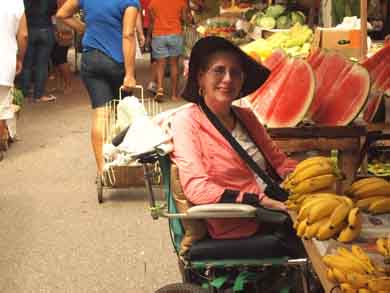
Photo: Shopping with the locals at Cobal Market in the neighborhood of LeBlon.
Marcelo has brought us to a number of places tourists would not ordinarily go. Around 10AM, we start at the Cobal Free Market in the Leblon neighborhood. It is a native open food market, several large city blocks square. Every imaginable fruit, vegetable and local seafood is on display. He tells us that the market will close by 2PM, as the fish will spoil and the vegetables will no longer be considered fresh.
Indeed, at 11AM the prices begin to drop. Although you will certainly pay more by shopping early, you get the best choice of any item you want to buy. We see nothing that is anything less than excellent however, and this market has a reputation for the quality of goods available for sale.
Not even noon, and it is already scorching hot. The humidity hangs on your shoulders like a warm, wet blanket. Marcelo buys a cold, fresh fruit sugar cane drink for Nancy. She drains it- never offering even a sip to her suffering, parched husband ;-))
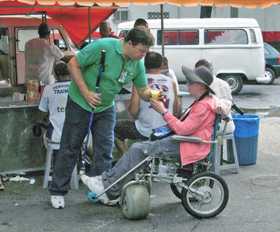
Now we drive outside the city, on a road along the coast, passing numerous new condominiums, which gradually give way to a Nature Preserve of great dimensions. Eventually the road becomes reminiscent of Highway 101 along the California coast. The area is known as the Barra da Tijuca, and its beach is the longest in Rio de Janeiro.
We are headed to a small beach Marcelo knows from his childhood, the Praia do Pepe.
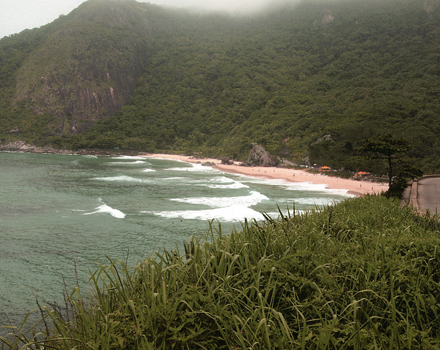
Photo: The small beach known as the Praia do Pepe
Pepe was the nickname of a young boy who sold beer and mineral water along the beach. Hi introduced hand gliding into the area, and in fact, was killed some years ago while flying.
He was very popular and people decided to honor his memory by naming this small extension of beach after him. This is clearly a place of significant memories for Marcelo, and we decide to stop and have lunch at one of the roadside eateries.
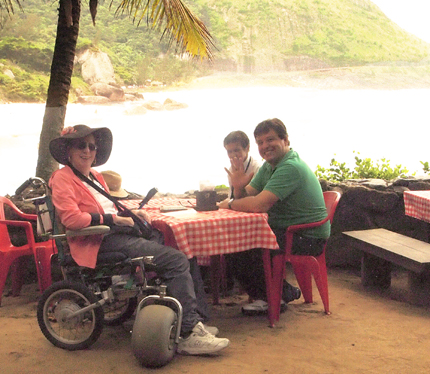
Lunch with our great guide, Marcelo, and Eduoard, the best driver we've ever had.
... and the largest urban rainforest in South America |
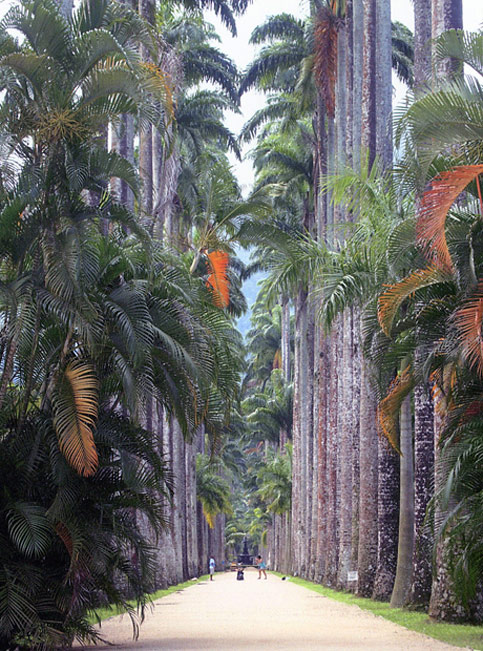
It is because of the far- sightedness of King Don Pedro II. In 1861, worried about the deforestation around Rio de Janeiro, he ordered the creation of Tijuca National Park (Parque Nacional da Tijuca).
He ordered a replanting of the area that had been stripped of native vegetation by the coffee and sugar cane plantations, and over the next ten years, he created the 8,000 acre rainforest, now home to 30 waterfalls, hundreds of plants and trees, and at least 100 different species of animals.
The park actually reduces the median temperature of the city by approximately nine degrees and because it absorbs carbon emissions, it limits the air pollution in the city.
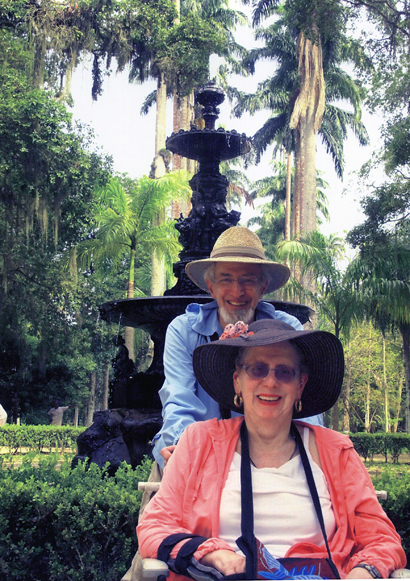
Taking a break from Rio de Janeiro proper, we next go to the town of Niteroi. In a relationship similar to San Francisco and Sausilito, Niteroi is separated from Rio by the Guanabara Bay. You can get there by driving over the Rio-Niteroi Bridge (which for a long time was the longest bridge of its kind in the world). Unfortunately, the traffic destroys all the calm and "laid- backness" of your mood.
However, you can take a ferry from the Praca Quinze de Novembro terminal, which is fun and relaxing. The choice for us was a no brainer. We took the ferry, leaving poor Eduoard to drive over and meet us.
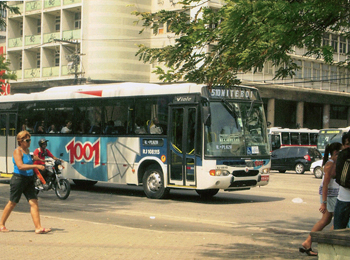
Niteroi has become the second largest city in the State. There are magnificent condominiums, great restaurants and good cultural attractions. Many people live there and commute to and from Rio de Janeiro.
|

Photo: Niteroi Modern Art Museum
Aside from its tremendous ambience, the main attraction is the Modern Art Museum, designed by world famous architecht Oscar Niemeyer. Built in 1996, it is shaped like the space ship in the movie, "The Day the Earth Stood Still" (1951), only flipped over on its top. The modern lines of the building is stark, arresting, and beautiful. Fortunately, Gort did not appear.
The museum displays mostly works from scores of important Brazilian artists, mostly from the 1980's. The structure sits right on the edge of the land, and the view of Guanabara Bay are spectacular. Note that the windows completely encircle the museum, offering unique views of Sugarloaf, Christ the Redeemer, and a broad sweep of the Rio de Janeiro skyline. It is breath-taking!
If you continue around the bay, you pass through several villages whose names are not especially important. We drove this route, satisfying Marcelo's intention of taking us to a special restaurant he knows about, one clearly off the tourist path, in Jurujuba.
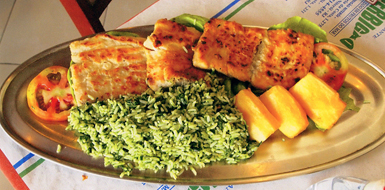
Caught perhaps an hour earlier, the fish was as delicious as it looks. We had one of the finest, freshest dinners in memory, at most reasonable prices.
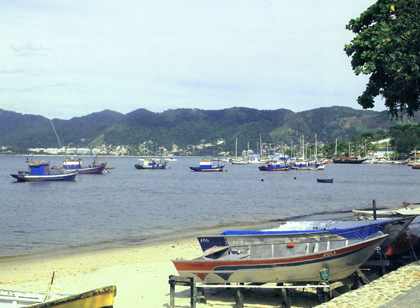
Photo: Lovely view of harbor and fishing fleet in Jurujuba
A few final words before we leave Rio de Janeiro and move on.
Marcelo, our guide, was frustrated! He had booked reservations for us at a top Rio night club, wanting us to experience, first-hand, the rhythms and flavor of Brazilian music; to see the samba performed by the people who "invented" it. Unfortunately, all such clubs open much too late for Nancy and me, and we had to pass on that.
In its place, he took us to Luis Gonzales Park, named for the man whose accordion produced some of the most distinctive Latin rhythms
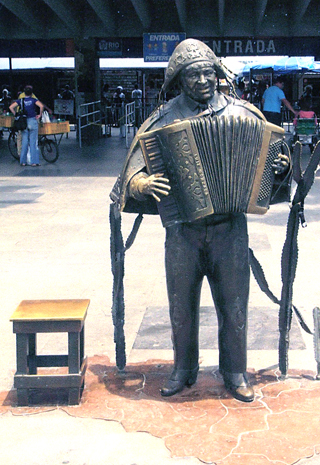
Statue honoring Luis Gonzales, father of modern Latin rhythms
Poor Marcelo! Same story. Usually packed with dancers, singers and players from around 10PM until 5 or 6AM, neither of those times work for us, either.
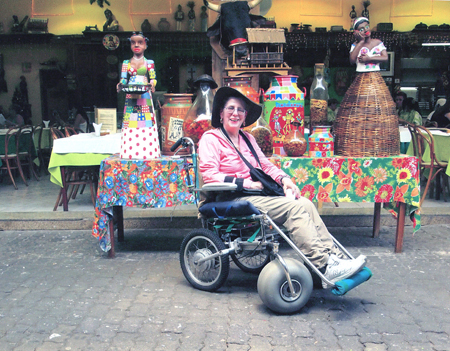
Not to worry. We had the greatest time ever! Thanks Marcelo and Eduoard.
***************************************************************
We depart Rio de Janeiro by plane, headed to the city of Manaus (12th largest city in Brazil), which sits at the headwaters of the Amazon River. It has a population of a little over 2 million people, the most in all of Northern Brazil.
Back around the turn of the nineteenth century, Manaus was home to the newly developing rubber industry, and some of its inhabitants grew enormously wealthy, and desired to make their city as elegant and sophisticated as possible. Although it was paid for with public funds, the Opera House is one of the most visible of the efforts to make Manaus the enviable jewel of Northern Brazil. |
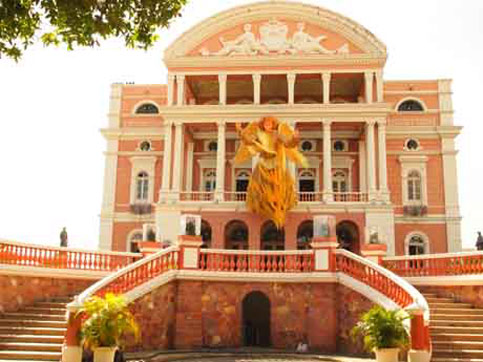
Photo: Opera House from 1896 in Manaus, Brazil. It is almost Christmas and the Opera House has been decorated with this golden angel in front.
Manaus is the home port of the river boat, Iberostar Grand Amazon, a floating hotel, the only such on the Amazon River that has an elevator. She is not really handicap accessible, but the general manager and his staff were tremendously helpful, and we were comfortable sailing aboard her for eight days as part of our 50th wedding anniversary. You can see the ship and read about our trip in the chapter on the Amazon.
Manaus has no road connection with any other city in Brazil, so if you want to travel there, you arrive either by plane or ship. We did both! |
| We spent just a day in the actual city- but that was enough time to find the city captivating. Busy, bustling, thriving and throbbing. |
We shopped and had a bite to eat in the main marketplace, perhaps the only non-Brazilians there. The prices were quite reasonable and it was a totally enjoyable day. |
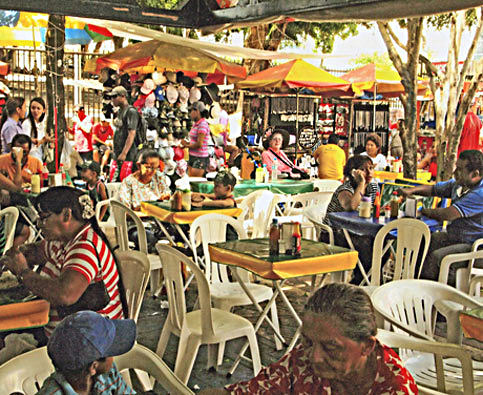
Nancy is in the upper center, wearing a pink shirt at the table with the green tablecloth. As you can see, the place was packed!
At the end of the day, back on ship, we were treated to a splendid sunset and a great shot of the Manaus skyline.
|
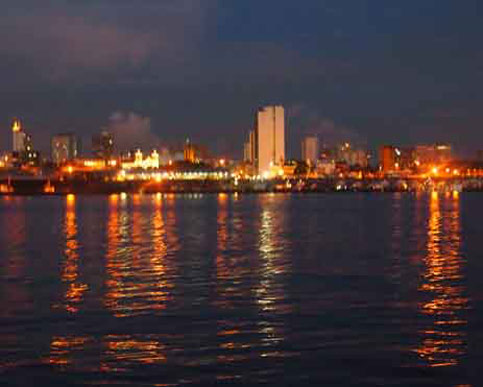
Remember, this place is miles from anywhere, in the middle of the Amazon jungle. Unbelievable!
|
Have you checked the most important parts of our website? We urge you to go to the Chapter on Essential Plans. Then, whether they apply to you or not, read the Chapters Airlines, Cruises, Hotels, Taxis, Tours. Finally, be sure you read the Chapter Items to Take. The information in these chapters will make all the difference in the success of your trip.
|
Contact Us
Please feel free to contact us if you have questions, suggestions, comments or just some friend words by clicking on our contact form |
Please also go to our Disabled Travelers Guide to the World for many additional tips on arranging tours, transport and other details. See, especially, Chapter 8- About Tour Guides. And don't miss valuable information in Chapter 12- About Bargaining and Negotiating. |
|
|
|
